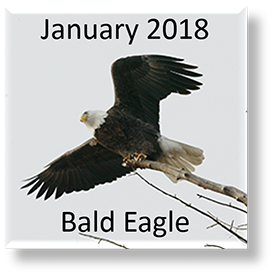 bald eagle Haliaeetus leucocephalus
bald eagle Haliaeetus leucocephalus
What is a Bald Eagle?
A bald eagle is a bird. Specifically, it is a raptor. Birds are warm-blooded animals with feathers, hard-shelled eggs and lightweight bones. Because they are warm-blooded, birds can maintain a constant internal body temperature and be active when their natural environment has extremes of very warm or very cold conditions. Feathers are used for flight, protection and attraction of a mate. They also aid in controlling body temperature and in helping birds to identify other birds. Birds lay hard-shelled eggs. The hard shell, made mostly of calcium carbonate, keeps the egg from drying out and allows parents to sit on the eggs during incubation. Lightweight bones are necessary for flight. Bird bones are strong and have internal braces. Many bird bones are filled with air and are connected to the respiratory system. Other bones are fused together, increasing their strength. Raptors have large eyes that face forward. They have a hooked beak and sharp talons.
What Does It Look Like?
The adult bald eagle has white feathers on its head, neck and tail. The body feathers are brown. Young eagles do not develop the white feathers until they are two or three years old. Young eagles have brown feathers. The bill, eyes and feet of a bald eagle are yellow.
How Big Is It?
A bald eagle is about 30 to 36 inches long with a wingspan of 70 to 90 inches. The average weight of a bald eagle is eight to 14 pounds. Female bald eagles are up to one-third larger than male bald eagles.
Where Does It Live?
The bald eagle lives near large rivers and large lakes that have big trees near them. It can be seen statewide as a migrant and winter resident, but some eagles are summer residents in the state, too. Many bald eagles move into the state from the north to overwinter.
How Does It Reproduce?
Eagles first mate when they are four or five years old. When courting, the male and female lock talons while in flight. They fall in somersaults for several hundred feet as part of this ritual.
The nest is built in a large tree, such as a cottonwood or sycamore. It is a mound of sticks that is lined with other items. The male and female both work to build the nest. They often use the same nest for several years.
Usually two eggs are laid in the nest, but sometimes only one egg or as many as three eggs may be present. Eggs are laid during March or April. Parents take turns incubating the eggs. The process takes 34 to 36 days. Both parents feed the young birds. The young birds begin to fly 10-12 weeks after they hatch.
What Does It Eat?
Fishes, small birds, dead animals, turtles, cottontails and wounded or ill waterfowl make up most of their food. They sometimes steal food from smaller birds, too.
Does Anything Eat It?
Adult eagles have no predators, but humans can cause disturbance and/or death of eagles. If an adult eagle is badly injured, several animal species would catch and eat it. Eagle eggs and young are sometimes eaten by gulls, American crows (Corvus brachyrhynchos), hawks, owls, other eagles, raccoons (Procyon lotor) and bobcats (Lynx rufus).
What Else Should I Know About It?
The bald eagle was chosen as the symbol of the United States for its strength and pride.
Bald eagles may have the same mate for their lifetime.
These large birds can travel up to 45 miles per hour when flying.

